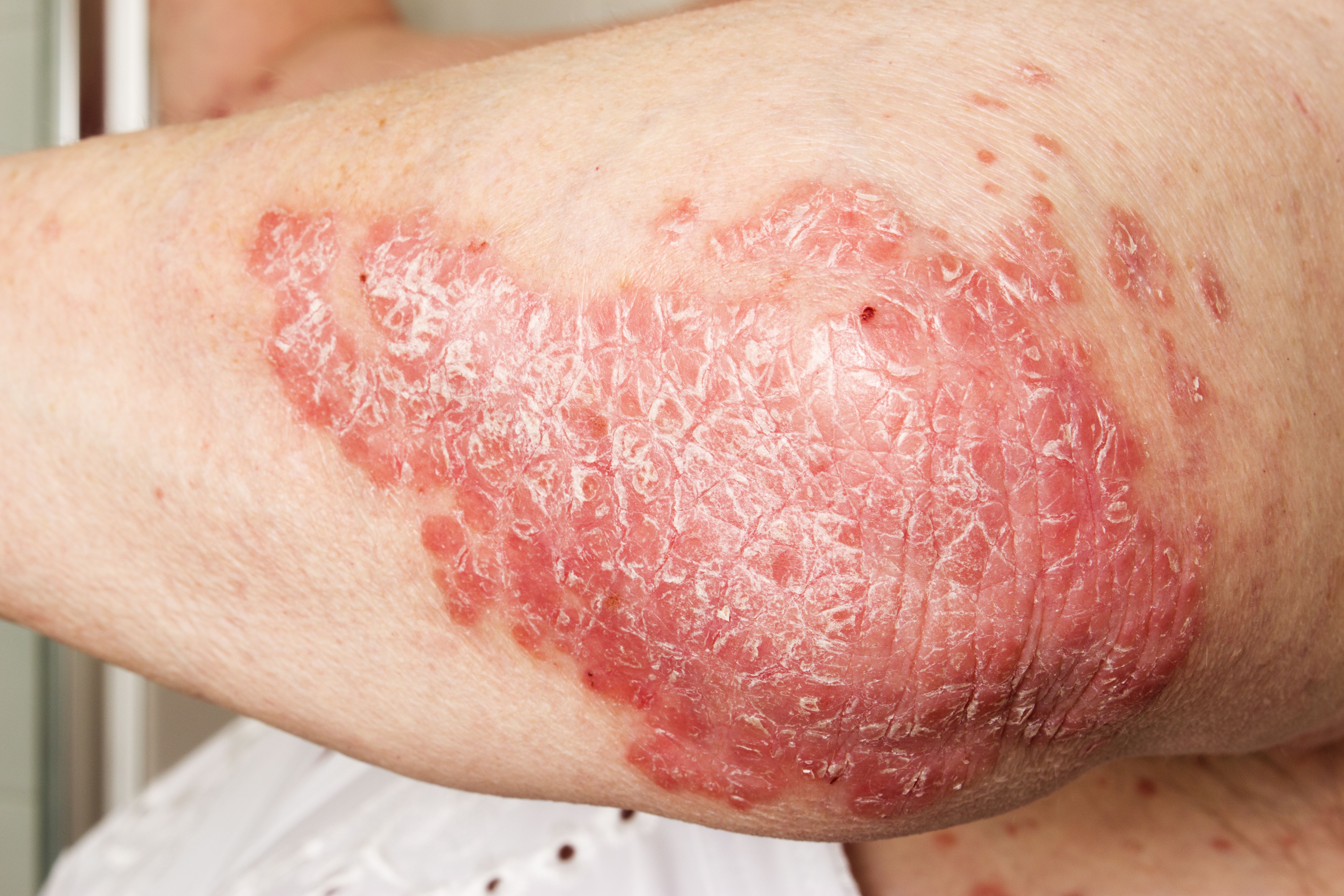- Case-Based Roundtable
- General Dermatology
- Eczema
- Chronic Hand Eczema
- Alopecia
- Aesthetics
- Vitiligo
- COVID-19
- Actinic Keratosis
- Precision Medicine and Biologics
- Rare Disease
- Wound Care
- Rosacea
- Psoriasis
- Psoriatic Arthritis
- Atopic Dermatitis
- Melasma
- NP and PA
- Skin Cancer
- Hidradenitis Suppurativa
- Drug Watch
- Pigmentary Disorders
- Acne
- Pediatric Dermatology
- Practice Management
- Prurigo Nodularis
- Buy-and-Bill
Publication
Article
Dermatology Times
JAK inhibitors offer multiple applications
Author(s):
Unlike prior generations of dermatologic drugs, Janus kinase (JAK) inhibitors show potential for treating numerous dermatologic indications. Brett King, M.D., Ph.D. explored what this class of drug has to offer in his presentation during AAD earlier this month.
In the coming years, dermatologists will be able to get comfortable using JAK inhibitors for AD, psoriasis, AA, vitiligo and other conditions, says Brett King, M.D., Ph.D.

Brett King, M.D., Ph.D.

Unlike prior generations of dermatologic drugs, Janus kinase (JAK) inhibitors show potential for treating numerous dermatologic indications including atopic dermatitis (AD), alopecia areata, psoriasis and vitiligo.
Brett King, M.D., Ph.D., said it is unusual for a medical conference session to feature a single class of drugs with several dermatologic disease states organized around it, rather than the converse. He is associate professor of dermatology at Yale University School of Medicine.
Usually, Dr. King explained, a single disease or condition takes center stage, with treatments from various drug classes being highlighted in different presentations. "However, JAK inhibitors as a class are affecting treatment of vitiligo, alopecia areata, atopic dermatitis, psoriasis, connective tissue diseases and granulomatous diseases. It's a remarkable concept."1
The TNF inhibitors were revolutionary when they debuted more than 14 years ago, said Dr. King. "These medicines helped define a new era of targeted therapy for psoriasis.” But to this day, he added, TNF inhibitors (adalimumab specifically) are approved for only two dermatologic indications - psoriasis and hidradenitis suppurativa. "All of the drugs we've seen developed for psoriasis are usually for one condition in dermatology. JAK inhibitors are a class of drugs that will span many conditions in dermatology."
In our armamentarium of treatments, he said, prednisone is probably history's greatest example of a single drug that impacts innumerable pathways and disease mechanisms - and has many potential adverse effects. More targeted drugs include the systemic immunomodulators methotrexate, azathioprine, mycophenolate mofetil and cyclosporine. "While they all have specific mechanisms, they still suppress broad swatches of the immune system - T cell and, variably, B cell immunity."
Dermatologists' increasingly detailed understanding of psoriasis pathogenesis has paved the way for highly targeted biologic therapies for this disease. Following the TNF inhibitors, newer generation biologics for psoriasis target interleukin (IL)-12 and IL-23 (ustekinumab), IL-17 (secukinumab, ixekizumab, brodalumab) and IL-23 (guselkumab, risankizumab, tildrakizumab). Similarly, said Dr. King, advances in our understanding of AD pathogenesis have led to dupilumab (which targets IL-4 and IL-13), the first FDA-approved targeted therapy for moderate to severe AD.
"Dermatologic (and other) diseases are sometimes driven by cytokines that course through the blood and tissues communicating signals to different cells. Sometimes those signals eventuate in disease. Our goal is to interrupt those signals when they are pathogenic."
Strategies for interrupting or modulating cytokine signaling include developing antibodies to specific cytokines; for instance, IL-23 inhibitors. Alternatively, said Dr. King, one could block cytokine receptors, which are the docking sites on the cell surface where cytokines bind.
"Or you can disrupt cytokine signaling by giving a JAK inhibitor, which inhibits the first part of the signaling cascade on the inside of the cell." Cytokine signaling can be thought of like a relay race, he said. A pathogenic cytokine - for example, interferon-gamma or IL-23 - passes the baton to JAK enzymes, which pass the baton to STAT proteins. "STAT in turn passes the baton to the nucleus, where genes are transcribed, and disease happens.2 I want to interrupt this relay race. If I can keep any one of the runners from taking the baton, the signal never makes it to the nucleus."
The antibody and receptor-blocking strategies work on the outside of the cell, said Dr. King, while JAK inhibitors are small molecules that bind to and prevent activity of JAK family enzymes within the cell.
JAK inhibitors can variably target different JAK family enzymes and therefore can be more or less specific, he said. Tofacitinib, for instance, targets JAK1 and JAK3, and less so JAK2, and therefore affects many processes, said Dr. King. More targeted drugs impact primarily JAK3 (thereby impacting processes governed by IL-2, IL-4, IL-7, IL-9 or IL-15), for example, or tyrosine kinase 2 (Tyk2). "More targeted JAK inhibitors potentially affect specific disease processes, with less collateral impact.”
More than 50 cytokines use the JAK-STAT pathway, said Dr. King, and many of these mediate dermatological diseases. “And so it is that JAK inhibitors will be effective for treating many of the diseases that we commonly see in dermatology."
JAK inhibitors currently approved by the FDA and/or European Medicines Agency include tofacitinib (for rheumatoid arthritis/RA), psoriatic arthritis and ulcerative colitis), ruxolitinib (for myelofibrosis and polycythemia vera) and baricitinib (for moderate-to-severe RA). Among experimental drugs, PF-06651600 (Pfizer), targets JAK3. Drugs in development that target Tyk2 include BMS-986165 (Bristol-Myers Squibb) and PF-06700841 (Pfizer). BMS-986165 is currently in phase 3 trials in psoriasis. In January, Pfizer initiated a phase 2b/3 trial of PF-06651600 in AA.
In the coming years, said Dr. King, dermatologists will be able to get comfortable using JAK inhibitors for AD, psoriasis, AA, vitiligo and other conditions. "There's an opportunity here that we have not previously seen in dermatology."
Disclosures: Dr. King is a clinical trial investigator and has received consulting fees and/or honoraria from Concert Pharmaceuticals, Eli Lilly and Pfizer. He is also a speaker for Pfizer, Regeneron and Sanofi Genzyme, and has received honoraria and/or consulting fees from Aclaris Therapeutics and Dermavant Sciences.
References:
1. King B. The clinical impact of the JAK/STAT pathway. Session S016. American Academy of Dermatology Annual Meeting; March 1, 2019; Washington, D.C.
2. Gadina M, Johnson C, Schwartz D, et al. Translational and clinical advances in JAK-STAT biology: The present and future of jakinibs. J Leukoc Biol. 2018;104(3):499-514.







